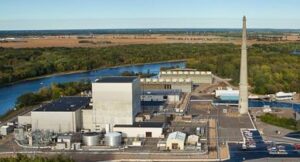
(Photo/ Nuclear Regulatory Commission)
By John LaForge
In April, I reported on false assurances made by Xcel Energy and the Nuclear Regulatory Commission (NRC) regarding the November 2022 leak from the Monticello nuclear reactor of some 829,000 gallons of cooling water containing a huge concentration of radioactive tritium (technically, 5.2 million picocuries per liter).
In eye-opening remarks at the Monticello Community Center on May 15, NRC Senior Environmental Project Manager, Stephen J. Koenick, apologized for the commission staff’s often-repeated claims that leaked tritium from the 53-year-old reactor had not reached the Mississippi River — drinking water source for 20 million people, including the Minneapolis/St. Paul metro area.
In his underreported apology, Koenick said, “I would like to take a moment to address and clarify some miscommunication regarding the presence of detectable tritium in the Mississippi River. I know we … reported there were no indication[s] of [a] tritium leak [which] made it to the Mississippi. However, … in our Draft Environmental Impact Statement, we … conclude there were some very low concentrations of tritium in the Mississippi River.” Koenick went on to say, “So we apologize for this miscommunication.”
The weekly Monticello Times
reported on the vanishingly rare public confession and its crucial admission that radioactive tritium from the massive 2022 leak had contaminated the Mississippi. The paper published a report on the front-page on Jun. 6, under the headline: “NRC apologizes, changes its stance on tritium leak: Now says low concentrations got into Mississippi River.”
What Koenick meant by “miscommunication” were false assurances made to the press that no tritium had been found by Xcel’s testing of the river. On Mar. 18, 2023, NRC spokesperson Viktoria Mitlyng even told the press, “There is no pathway for the tritium to get into drinking water.” As recently as May 7, 2024, NRC presenters at a separate NRC-sponsored public hearing, also held in Monticello, said that Xcel had found “no detectable levels” of tritium in the river.
Tritium is the radioactive form of hydrogen. It cannot be removed by any kind of filtering and contaminates huge volumes of regular water that it contacts. Tritium is a danger to health if taken internally, by drinking or breathing, because it moves like water to every part of the body, and because it crosses the placenta where it endangers the fetus and causes birth abnormalities and problem pregnancies.
Xcel has applied for a second operating license extension for the Monticello jalopy which, if granted, would allow the reactor, one of the three oldest in the country, to run until the age of 80. Over 3,000 public comments have been sent to the NRC regarding its Draft Environmental Impact Statement on the 80-year-risk — most of them voicing alarmed opposition.
A second scandal brewing?
While studying the NRC’s Draft EIS, Nukewatch’s Lindsay Potter discovered an extremely odd coincidence.
As with any environmental impact study, the NRC has to establish a formal calendar for information-gathering. The data collection time-frame for the Monticello draft officially ended on Aug. 18, 2023.
According to Xcel Energy and NRC documents, Aug. 18 was the very same day that radioactive tritium contamination in Xcel’s groundwater tests near the Mississippi River exceeded the federal EPA drinking water limit. (Technically 20,000 picocuries per liter.)
Curiously, high and rapidly increasing levels of tritium (from the plume created by the major 2022 leak) was detected in a monitoring well near the river, beginning July 27, 2023. Then, tests over the following three weeks show the concentration of tritium grew five-fold, the documents show, until on Aug. 18 when the tritium concentration exceeded the U.S. EPA’s drinking water allowable max.
As a result of the NRC’s data collection cut-off date, the Draft EIS omits the critical time-frame immediately after August 18, when tritium levels were above permitted limits and still increasing.
Likewise, Xcel’s “2023 Annual Radioactive Effluent Release Report” submitted to the NRC, fails to provide precise data on groundwater monitoring tests results following Aug. 18, 2023, noting in general terms only that tests done after Aug. 18, 2023 found no unsafe levels of contamination.
Based on past “miscommunications,” readers can decide whether such public assurances are reliable.
John LaForge is a Co-director of Nukewatch, a peace and environmental watchdog group in Wisconsin, edits the group’s Quarterly newsletter, and with Arianne Peterson co-edited Nuclear Heartland, Revised Edition: A guide to the 450 land-based missiles of the United States.






















